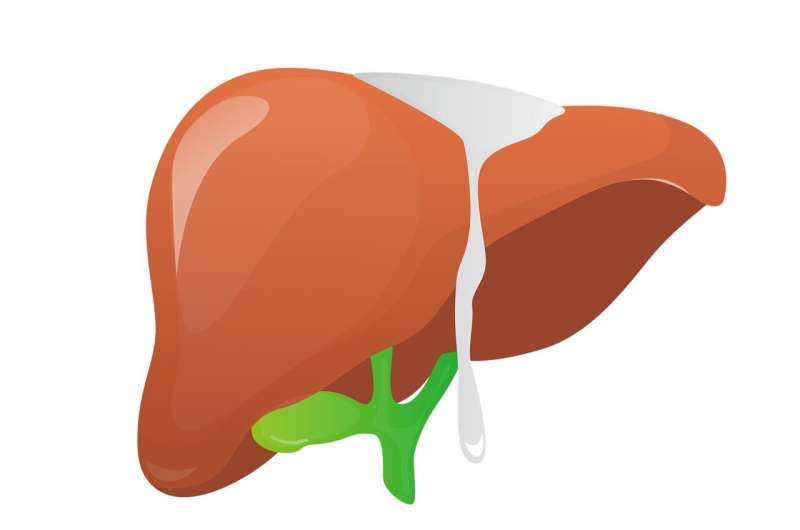
A deeper understanding of a gene that predisposes patients to fatty liver disease may open new avenues for treatment of the condition, according to Yale research published in Cellular and Molecular Gastroenterology and Hepatology.
Fatty liver disease is characterized by a buildup of excess fat in the liver. In the case of metabolic associated dysfunction steatotic disease (MASLD)—one type of fatty liver disease—certain genetic variants put patients at a higher risk of developing excess fat in their liver.
Now, new research shows that this fat buildup can be prevented in mice that are genetically predisposed to the disease by targeting hormones that work on fat deposits outside of the liver.
While just a first step, this study suggests that beta blockers—medications that obstruct certain hormone receptors and are often used to treat heart conditions—could be a promising avenue for treating patients with a genetic predisposition to fatty liver disease, says Daniel Vatner, MD, Ph.D., assistant professor of medicine (endocrinology) at Yale School of Medicine and senior author of the study.
Fatty liver disease is on the rise
A buildup of fat in the liver can have dire consequences for someone’s health. Too much fat can cause inflammation and scarring that permanently damages the organ, forcing some patients to require a liver transplant. This damage can also put people at higher risk of developing liver cancer.
Obesity and type 2 diabetes are both risk factors for developing fatty liver disease. Research estimates that around 30% of people worldwide suffer from fatty liver disease that isn’t linked to alcohol consumption. This population is expected to grow with the rising number of people developing diabetes and obesity.
Even with these risk factors, genetics are a key factor in who gets fatty liver disease. One variant in particular is responsible for the highest number of genetically wrought MASLD cases: the variant PNPLA3I148M.
However, how this variant causes fat to build up in the liver is still unclear. This matters, because understanding how genetic changes contribute to fatty liver disease can help researchers uncover the root causes of fat buildup, and—it is hoped—treat the condition.
Previous studies have found that PNPLA3I148M appears to cause changes both inside and outside of the liver. In this latest research, researchers at Yale used genetically modified mice that carry PNPLA3I148M to understand how changes outside of the liver might affect the progress of liver disease. They found that modified mice fed a high-sugar diet accumulated less fat in adipose tissue—the normal fat deposits found around the body—but more fat in the liver than did mice without the variant.
According to Vatner, “This was a clue that there might be some form of adipose tissue dysfunction to be discovered.”
Hormones and fat
How much and where fat is deposited in the body is shaped in part by a group of hormones called catecholamines, which include adrenaline and noradrenaline. To see whether catecholamines were impacted by the genetic variant, Vatner and his team treated PNPLA3I148M mice with a drug that behaved much like the hormones.
Mice that were exposed to the drug broke down more adipose fat than those that didn’t receive the drug, and that fat then accumulated in the liver. This suggests catecholamines circulating throughout the body are a player in how the gene shapes disease in the liver.
To see if they could interrupt this effect, the researchers treated some PNPLA3I148M mice with beta blockers: propranolol, commonly used to treat high blood pressure, and acipimox, which is used to lower triglycerides. Beta blockers counteract catecholamines like adrenaline by blocking the receptor to which the catecholamines bind.
Mice with the genetic variant exposed to both types of beta blockers were less likely to build up fat in their livers than regular mice, suggesting that blocking catecholamine action outside of the liver could reduce the risk of fatty liver disease in PNPLA3I148M mice.
This doesn’t mean that MASLD patients will be taking propranolol anytime soon.
“Often in mice, it’s a little easier to see the response than in humans,” says Vatner. “Humans have all kinds of things going on that could affect fat buildup in the liver,” including alcohol consumption, diabetes, and rapid weight loss.
But the results suggest that beta blockers are something that researchers could investigate as a potential therapy for MASLD. In fact, Vatner is currently applying for grants from the National Institutes of Health to test whether these findings in mice can explain this disease in patients and whether beta blockers could help patients with a genetic predisposition to MASLD.
“What I hope is that 10 years down the road, we know enough about this work that we can say we’re developing new treatment strategies based on this science,” he says.
More information:
Jaya Prakash Golla et al, Altered catecholamine stimulated adipose lipolysis contributes to hepatic steatosis in Pnpla3I148M mice, Cellular and Molecular Gastroenterology and Hepatology (2025). DOI: 10.1016/j.jcmgh.2025.101500
Citation:
Targeting hormones could reduce risk of fatty liver disease (2025, March 26)
retrieved 26 March 2025
from https://medicalxpress.com/news/2025-03-hormones-fatty-liver-disease.html
This document is subject to copyright. Apart from any fair dealing for the purpose of private study or research, no
part may be reproduced without the written permission. The content is provided for information purposes only.






